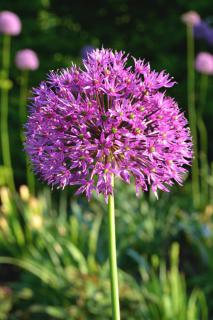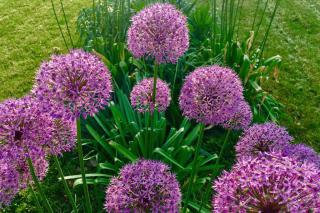

Ornamental onion is a beautiful perennial, known for its tall ornamental floral scapes.
Key Ornamental onion facts:
Name – Allium
Family – Liliaceae (lily family)
Type – perennial
Height – 8 to 40 inches (20 to 100 cm)
Exposure – full sun
Soil – ordinary
Flowering – May to July
Easy to grow, it is perfect in flower beds and also in pots or garden boxes to decorate terraces and balconies.
 For ornamental onion, planting is one of the most important steps: if well done, the growing and blooming will be much more impressive.
For ornamental onion, planting is one of the most important steps: if well done, the growing and blooming will be much more impressive.
Plant the onion bulbs anytime from September to December. Ideally, you’d group them in small clusters with at least 5 bulbs in each. You can set such clusters up in flower beds, landscaping mounds, or in a pot on a terrace or balcony (as long as its about 12 inches deep, or 20 cm). It needs full sun, but if there’s a little shade, it’s ok.
This is an easy bulb to care for, whatever the season.
It grows back and blooms every year as long as you do the following:
 Cut wilted flower scapes as they die off, cutting the stem off as short as you can.
Cut wilted flower scapes as they die off, cutting the stem off as short as you can.Ornamental onion is a perennial that grows quite easily and which will produce very beautiful flowers that can be up to 8 to 12 inches (20 to 30 cm) across. At the very tip of a long stem, this large sphere is comprised of hundreds of smaller flowers appears. Colors range from purple to dark blue.
It is also used in fresh flower bouquets, because the foliage and the flowers both can be used to make appealing compositions.
When the flower starts drying out, you’ll be thrilled to see it keeps its strong, round shape. This is perfect for dried flower bouquets, which are perfect to decorate your house around the Christmas season. It will look very stunning in a tall, thin vase.
In flower beds or along edges, and also along a wall or simply plunked in the middle of the yard, the ornamental impact of this plant is guaranteed! Pair it with other, shorter ornamental onions (even just chives), or with ixia, deep red tulips or pure white lily.
For taller species, stake the stem to keep it from folding under the wind.